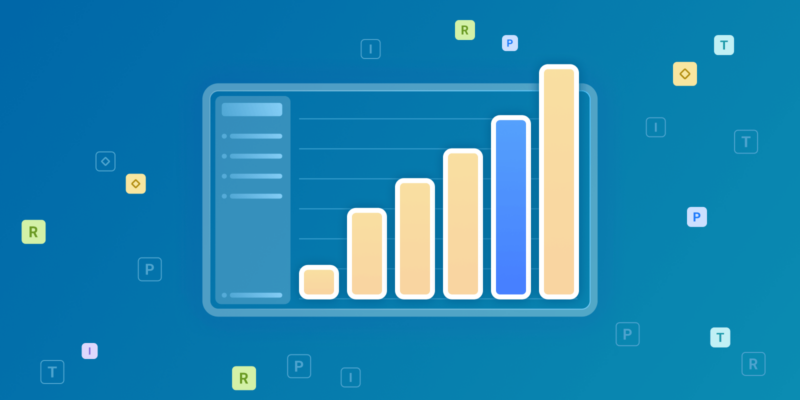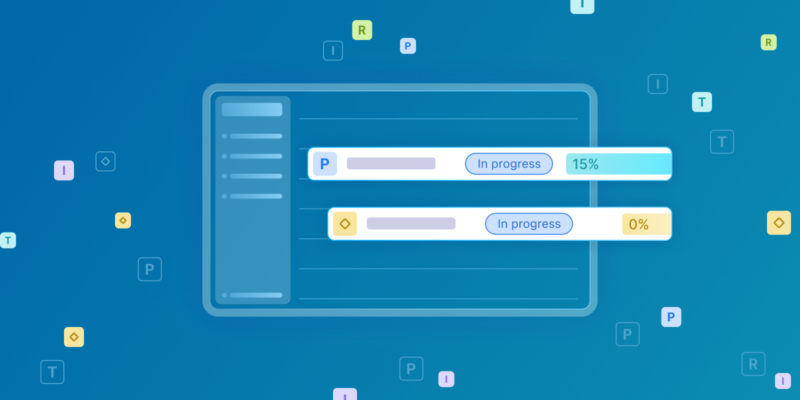When managing a project, understanding and organizing your resources is crucial to success. A Resource Breakdown Structure (RBS) is a tool that helps you do just that. It provides a clear, hierarchical view of all the resources required for your project, making it easier to allocate, manage, and monitor them throughout the project‘s lifecycle. Whether you‘re managing a small team or a large-scale initiative, an effective RBS ensures that nothing falls through the cracks, ultimately contributing to a smoother, more efficient project execution.
In this article, we‘ll guide you through everything you need to know about creating a Resource Breakdown Structure, from understanding its purpose to practical steps for building one tailored to your project‘s needs.
What is a resource breakdown structure (RBS)?
A resource breakdown structure (RBS) is a hierarchical chart that organizes and categorizes the resources needed to complete a project. These resources can include people, materials, equipment, and finances. The RBS breaks down these elements into manageable sections, providing a clear overview of what is required at each stage of the project. By visually mapping out all the resources, an RBS helps project managers ensure that every necessary resource is accounted for and properly allocated.
How does a resource breakdown structure work?
The RBS works by categorizing resources into different levels of detail. At the top level, you have broad categories such as personnel, equipment, and materials. Each of these categories is then broken down into more specific resources. For example, under personnel, you might have subcategories for different departments or skill sets. This hierarchical structure helps in identifying all required resources and understanding how they fit into the overall project. It also facilitates communication among team members by providing a common language for discussing resource needs and allocations.
Who creates the RBS?
Creating the RBS is typically the responsibility of the project manager or a designated resource manager. However, it‘s essential to involve key stakeholders in the process, including department heads, team leads, and subject matter experts. Their input ensures that the RBS is comprehensive and that all necessary resources are considered. Collaboration in creating the RBS also helps in aligning the project team‘s understanding of resource needs and availability.
Key elements of a resource breakdown structure
An effective resource breakdown structure (RBS) is built around several key elements, each tailored to the specific needs of your project. These elements provide a clear and organized view of all the resources required to complete your project successfully. Depending on the nature of your project, the items you include in your RBS might vary, but they generally fall into the following categories:
- Resource categories
These are broad groups that organize your resources. Common categories include:
-
- Human resources: This includes all personnel involved in the project, from project managers and team members to contractors and consultants.
- Materials: Any physical items required for the project, such as raw materials, components, or products.
- Equipment: Tools, machinery, and technology needed to complete project tasks. This could range from construction equipment to software licenses.
- Financial resources: The budget allocated for the project, including costs related to personnel, materials, and other expenses.
- Facilities: Physical spaces like office spaces, laboratories, or warehouses that are necessary for the project.
- Subcategories
These break down the resource categories into more specific groups, depending on your project‘s needs. Examples might include:
-
- For human resources: Different skill sets, roles, or departments (e.g., developers, designers, marketing specialists).
- For materials: Different types of materials (e.g., steel, plastic, or electronic components) or sources (e.g., suppliers, in-house production).
- For equipment: Specific types of equipment (e.g., heavy machinery, IT infrastructure, specialized tools).
- For financial resources: Specific budget items (e.g., salaries, travel expenses, procurement costs).
- For facilities: Specific locations or types of spaces (e.g., regional offices, manufacturing plants, testing labs).
- Codes or identifiers
To keep your RBS organized and easy to manage, each resource can be assigned a unique code or identifier. This helps with tracking and ensures that resources are easily referenced in project documents and communication. These codes might reflect the resource category, subcategory, or specific item, depending on the complexity of the project.
RBS vs. WBS: what‘s the difference?
While both the resource breakdown structure (RBS) and work breakdown structure (WBS) are crucial tools in project management, they serve different purposes. The WBS focuses on breaking down the project‘s deliverables into manageable tasks, detailing what needs to be done to complete the project. On the other hand, the RBS is all about what resources are needed to accomplish those tasks. Think of the WBS as your roadmap for the project and the RBS as the list of supplies you‘ll need for the journey. Both are essential, but they address different aspects of project planning and execution.
The role of a resource breakdown structures in project management
In project management, the RBS plays a pivotal role in resource planning and allocation. By clearly defining and categorizing the resources needed, an RBS helps project managers avoid resource shortages, over-allocations, and bottlenecks. It also aids in budgeting, as it provides a detailed account of all resources required, which can be translated into cost estimates. Moreover, an RBS supports effective communication and coordination among team members by providing a clear, shared understanding of resource needs and responsibilities.
Benefits of a resource breakdown structure in project management
The benefits of using a resource breakdown structure (RBS) in project management are significant, offering a clearer path to efficient resource use and successful project outcomes. Here‘s how an RBS can enhance your project management efforts:
- Improved resource allocation
An RBS ensures that resources are allocated effectively by breaking down project needs into detailed categories. This clear structure prevents over-allocation and under-utilization of resources, helping you distribute them strategically across tasks. The result is optimized resource use, leading to better project performance.
- Enhanced budgeting accuracy
By providing a detailed breakdown of all resources, an RBS helps you create more accurate budget estimates. With a clear view of costs related to personnel, materials, and equipment, you can reduce the risk of budget overruns and allocate financial resources where they are most needed.
- Risk management
An RBS allows you to identify potential resource-related risks early on, such as shortages or bottlenecks. By anticipating these issues, you can develop contingency plans and make proactive adjustments, minimizing the impact on the project and keeping it on track.
- Better communication
The hierarchical structure of an RBS offers a clear, visual representation of resource needs, making it easier to communicate with team members and stakeholders. This transparency fosters better collaboration and simplifies discussions around resource allocation or changes.
- Increased project success rate
An RBS contributes to smoother project execution by ensuring all necessary resources are properly identified, allocated, and managed. This structured approach reduces the likelihood of resource-related issues, helping you complete the project on time and within budget, ultimately boosting the chances of success.
6 steps to create a resource breakdown structure
Creating a resource breakdown structure (RBS) is a straightforward process that can greatly enhance the management of your project. Whether you‘re managing a small project or a large, complex one, these steps will help you craft an RBS that serves as a solid foundation for resource planning and allocation.
1. Define the project scope
Start by clearly defining your project‘s goals, deliverables, and key tasks. Understanding the full scope of your project is crucial because it directly influences the resources you‘ll need. You can also use project management tools, such as Birdview, to list all tasks and sub-tasks wittin your project. Take the time to outline what needs to be accomplished, and identify the major components of the project. This clarity will guide you as you start identifying the specific resources required at each stage.
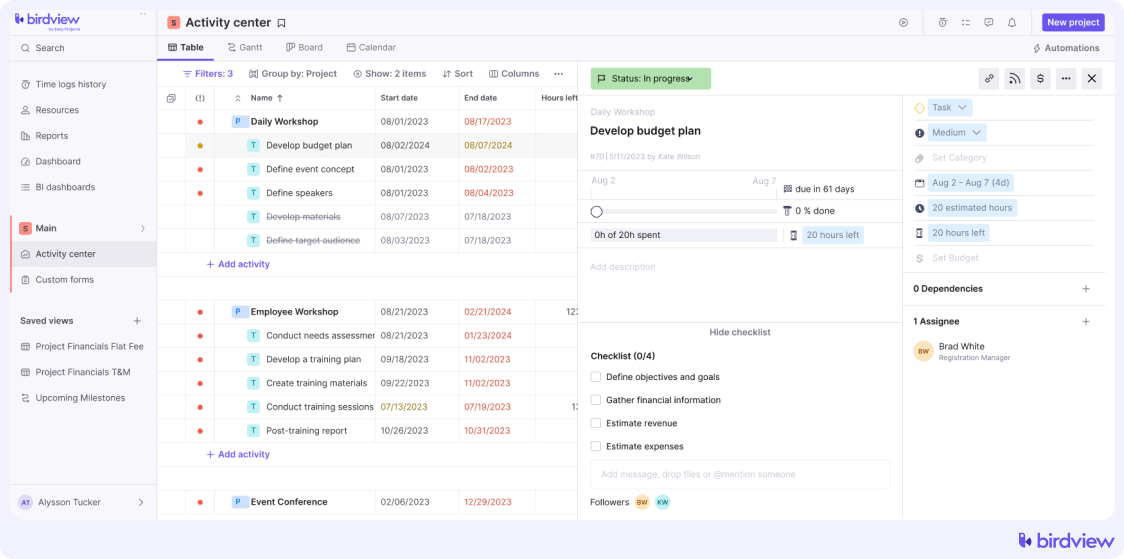
2. Identify required resources
Once you have a clear understanding of the project scope, begin listing all the resources necessary to achieve your goals. This includes personnel, materials, equipment, and financial resources. Think about every aspect of the project and consider the specific skills, tools, and budget you‘ll need. Be thorough in this step to ensure no resource is overlooked, as missing out on key resources can lead to challenges later on.
3. Organize resources into categories
With your list of resources in hand, group them into broad categories such as human resources, materials, equipment, and finances. This organization makes it easier to manage and track resources throughout the project. Within each category, you can further break down resources into subcategories based on their specific functions or characteristics. For example, human resources might be divided into roles like project managers, developers, and designers.
4. Create a hierarchical structure
Now, arrange the categories and subcategories into a hierarchical chart. This visual structure will become your RBS, providing a clear, easy-to-navigate overview of all resources. Start with the broadest categories at the top and work your way down to more specific items. This hierarchy helps in understanding how each resource fits into the overall project and allows for easier communication and planning.
5. Assign resources to tasks
After establishing your RBS, map the resources to specific tasks or work packages within the project using such tools as Birdview‘s resource management software. This step ensures that each task has the necessary resources to be completed successfully. Consider the timeline and dependencies of tasks to allocate resources efficiently. Make sure that resources are balanced across tasks to avoid overloading any single resource and to maintain a smooth workflow.
6. Review and validate the RBS
Finally, review your RBS with key stakeholders to ensure its completeness and accuracy. This is your opportunity to get feedback and make any necessary adjustments. Collaboration in this step is essential, as different team members might spot gaps or suggest improvements. Once validated, your RBS becomes a dynamic tool that you can update as the project evolves, helping you stay on top of resource management throughout the project‘s lifecycle.
Resource breakdown structure examples
To give you a clearer understanding of how an RBS can be applied in different scenarios, we‘ve compiled a set of examples across various industries. Each example provides a snapshot of how resources can be categorized and structured to meet the unique demands of specific project types.
Software Development Project

In the software development industry, projects are often complex, requiring a high level of coordination among diverse teams. A software development project typically involves creating, testing, and deploying applications or systems tailored to specific user needs.
Construction Project

Construction projects are highly complex and often involve multiple phases, from planning and design to execution and completion. In this industry, projects range from building residential homes to large-scale commercial developments.
Marketing Campaign
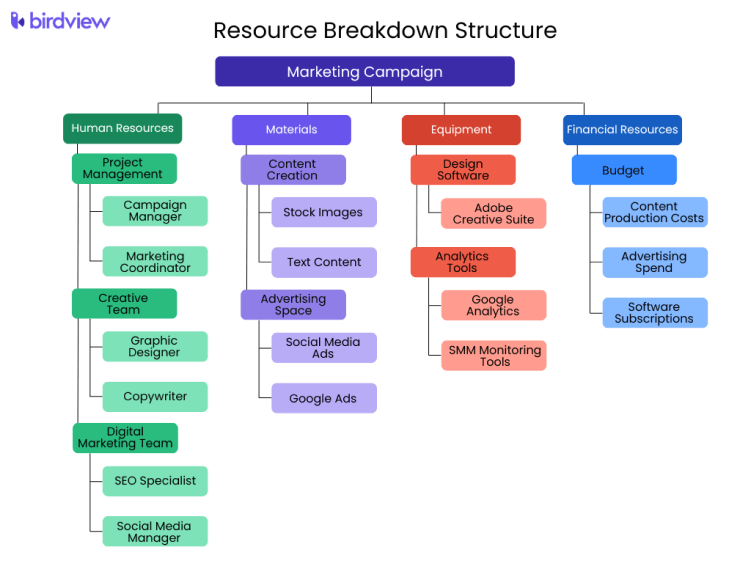
Marketing campaigns are designed to capture attention, drive engagement, and ultimately, increase sales or brand awareness. A marketing campaign project involves the strategic coordination of various creative and analytical resources.
Bringing your RBS to life with Resource Management Software
Now that you‘ve created your resource breakdown structure (RBS), it‘s time to put it into action on an actual project. Managing and optimizing your RBS is crucial to ensuring your project runs smoothly from start to finish. Birdview‘s resource management software offers a suite of powerful tools that help you do just that–making it easy to implement, monitor, and adjust your RBS in real-time as your project progresses. To see these and other Birdivew‘s tools in action, sign up for a free trial today or schedule a demo.
- Real-time resource tracking
With Birdview, you can monitor resource availability and allocation in real time, ensuring your project stays on track. Real-time tracking allows you to see how resources are being utilized at any moment, enabling you to make informed decisions quickly. This feature helps identify potential bottlenecks or underutilized resources, allowing for immediate adjustments to keep your project moving forward.
- Gantt chart vizualization
Gantt chart feature provides a visual representation of your project‘s timeline, including resource allocation. This tool allows you to see how resources are distributed across tasks over time, making it easier to manage workloads and deadlines. By integrating your RBS with the Gantt chart, you can ensure that resources are not only allocated correctly but also utilized efficiently throughout the project‘s duration.
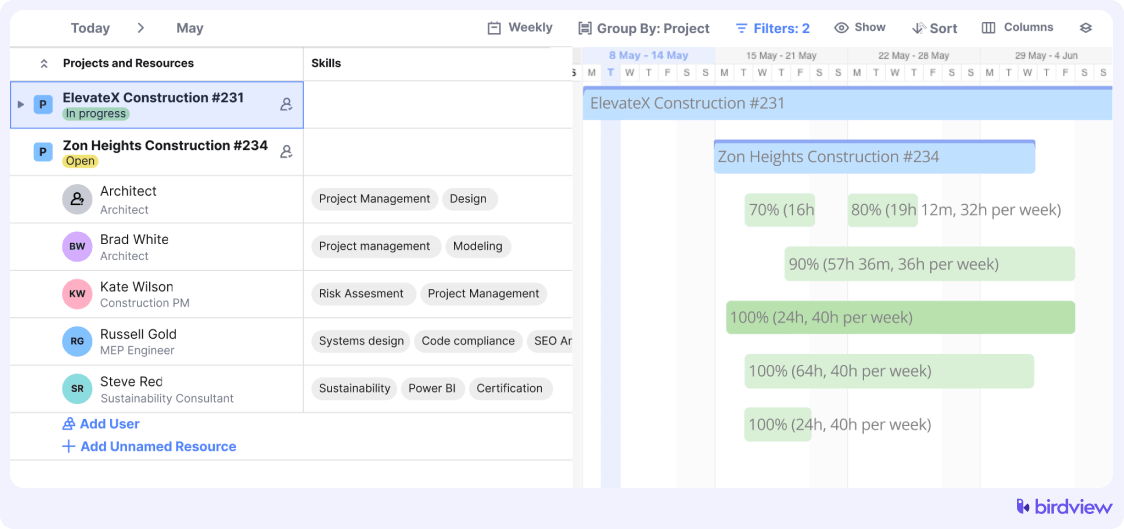
- Resource scheduling
Birdview‘s resource scheduling feature allows you to plan and manage resources with precision. You can schedule resources for specific tasks and time periods, ensuring that the right resources are available when needed. This feature helps prevent conflicts and over-allocations by providing a clear overview of resource assignments. With Birdview, you can adjust schedules as the project progresses, maintaining flexibility while keeping the project on track.
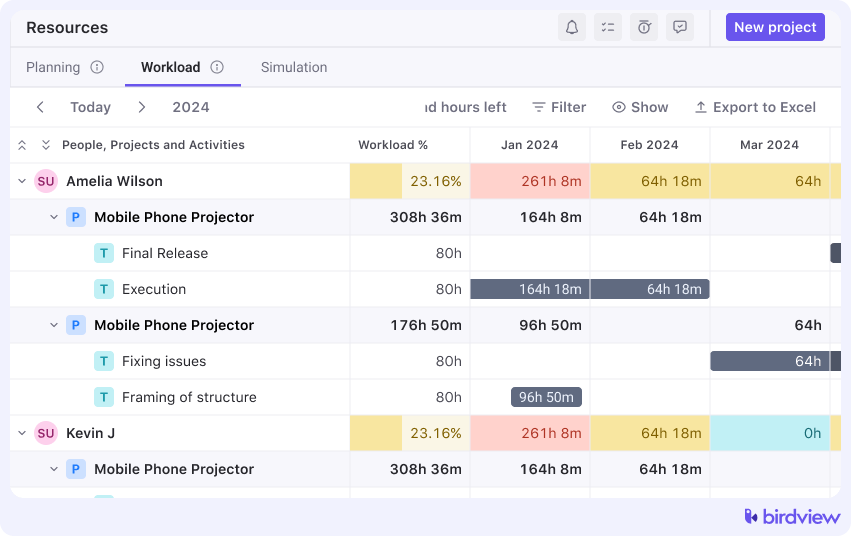
- Conflict resolution and resource allocation
Birdview ensures the best resources are allocated to the most important projects by allowing you to allocate resources based on your organization‘s priorities.It allows you to allocate resources using variables such as project type, client importance, timelines, business goals, and profitability. This targeted approach helps you efficiently manage conflicts or competing demands for resources, ensures that every project is adequately resourced, and promotes efficient, cost-effective utilization of your resources.
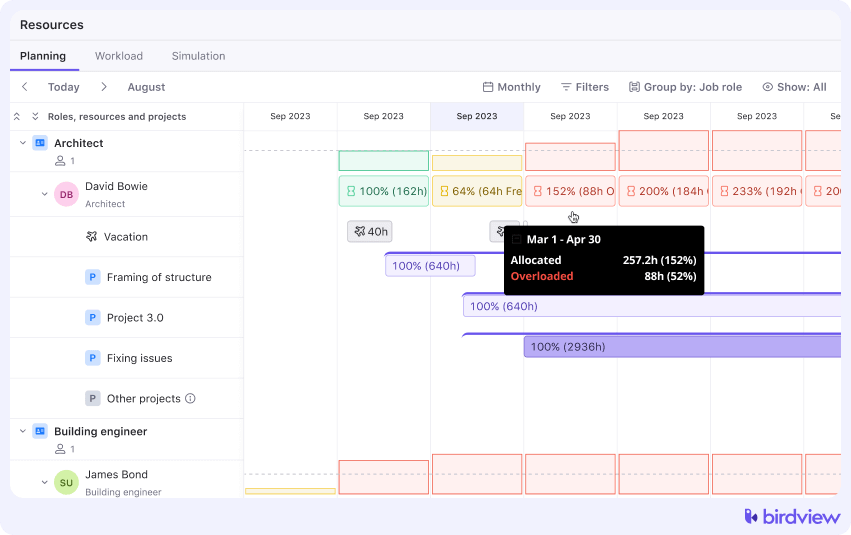
Resource allocation in Project Management
- Finding optimal resources
Birdview‘s AI Assistant helps you assemble a team that aligns perfectly with project requirements. You can choose the best-fitting candidates based on job roles, skill sets, availability, and hourly rates, and book resources needed for your project in advance. This feature ensures that you have the optimal team in place for successful project delivery.

- Resource management reporting and dashboards
Birdview‘s advanced reporting tools provide comprehensive insights into resource utilization and project performance. These dashboards allow you to track key metrics, monitor progress, and identify potential issues before they escalate. With detailed reporting capabilities, you can make data-driven decisions, improve transparency with stakeholders, and ensure that resources are being used effectively to meet project goals.
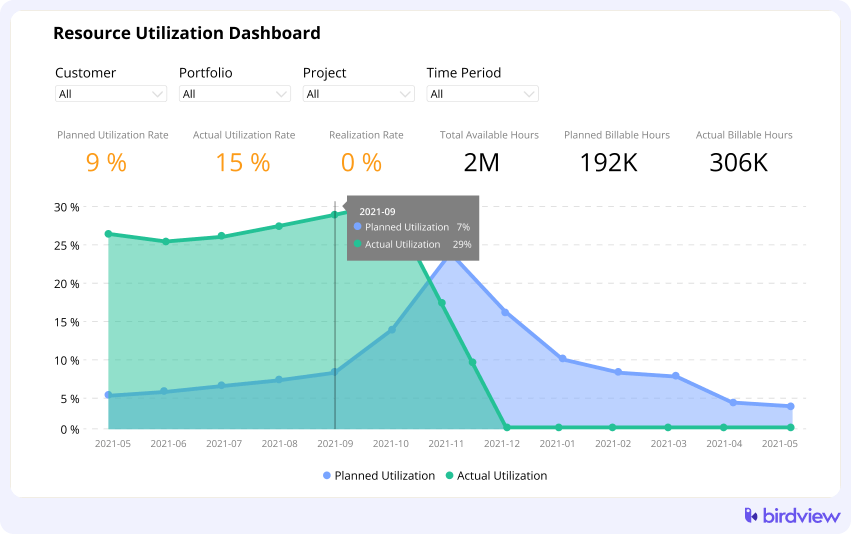
Resource management dashboards

